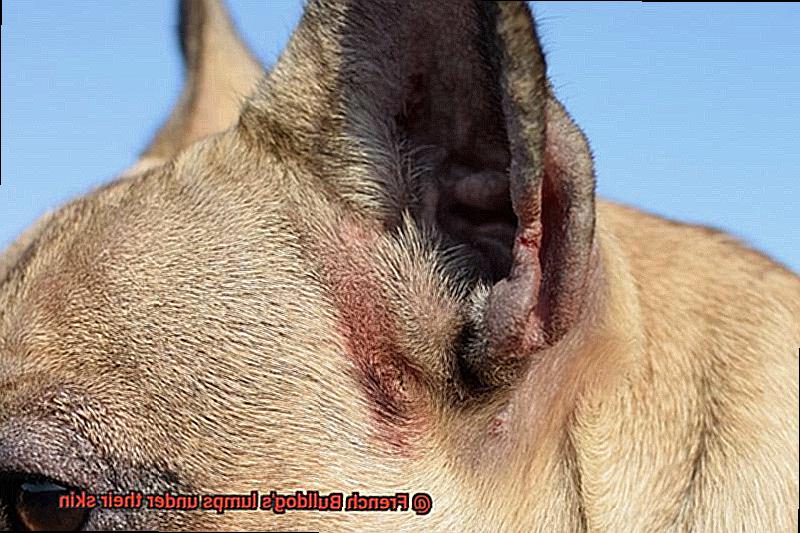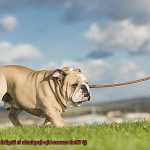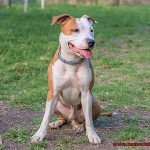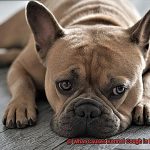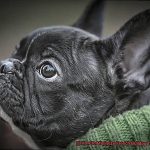French Bulldog’s lumps under their skin?
Do you own a French Bulldog? Have you noticed any lumps under their skin? If so, it’s important to know what they are and how to treat them.
Most of the lumps on French Bulldogs are perfectly normal and nothing to be concerned about. However, it’s also essential to distinguish between benign and malignant lumps so you can take appropriate action if necessary.
In this blog post, we’ll discuss the different kinds of lumps that can appear on your dog’s body, how to recognize them, and when veterinary care is required. We’ll also provide advice on how to keep your dog healthy and safe from potential health issues associated with these lumps.
It’s important to note that not all French Bulldogs are made equal. Some fatty deposits known as lipomas are usually harmless and don’t require surgery. Other cysts or tumors may be cancerous or benign, depending on the type. Therefore, it is vital to have any suspicious lump examined by a veterinarian to determine its origin and whether treatment is needed.
We hope this review has piqued your interest in learning more about French Bulldog lumps under their skin.
In our forthcoming blog posts, we’ll go into greater detail about the various types of lumps, how to recognize them, when veterinary care is required, and other important information about keeping your dog healthy and safe from potential health risks associated with these lumps.
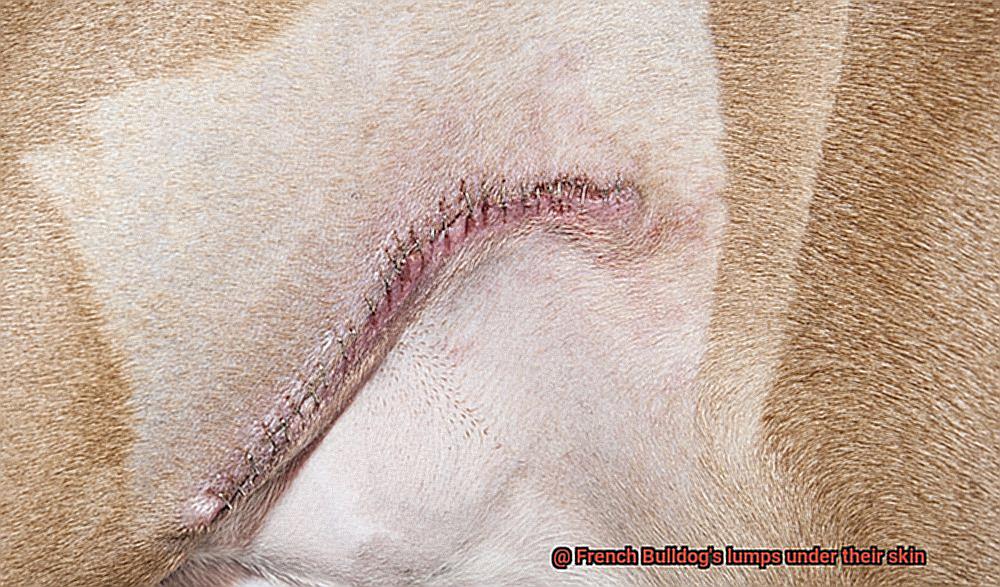
Let’s get started.
Common Types of Lumps on French Bulldogs
Contents
- 1 Common Types of Lumps on French Bulldogs
- 2 Causes of Lumps on French Bulldogs
- 3 Diagnosing and Treating French Bulldog Lumps
- 4 Cancerous Lumps in Dogs – Hard or Soft?
- 5 How to Check for Lumps Under Your Dog’s Skin
- 6 Prevention Tips for Reducing the Risk of Lump Development in French Bulldogs
- 7 When to See a Vet About Your Dog’s Lump
- 8 Conclusion
French Bulldogs are a beloved breed of dog, but they can be prone to developing lumps and bumps. Knowing the common types of lumps that your Frenchie may have can help you keep an eye on any changes in their skin. Here are the four most common lumps found on French Bulldogs:
- Fatty tumors are the most common type of lump and are usually benign.
- They can appear almost anywhere on the body and rarely cause any harm.
- Cysts are sacs filled with fluid and can occur anywhere as well.
- While generally harmless, they may need to be removed if they become too large or painful.
- Histiocytomas are small red bumps that may appear on a dog’s skin and can sometimes grow quite large.
- These lumps are typically benign but should be examined by a vet to rule out any potentially cancerous cells.
- Lastly, lipomas are soft, fatty lumps that form under the skin and usually don’t cause any harm, but they may need to be surgically removed if they become too large or uncomfortable for the dog.
It’s important to keep an eye out for any changes in your Frenchie’s skin, as some lumps may be cancerous or painful, requiring surgical removal if they become too large or painful.
Causes of Lumps on French Bulldogs
If you have a French Bulldog, it’s important to be aware of the potential causes of lumps on their skin. These can range from skin infections and allergies to the more serious possibility of cancer.
Bacterial, fungal, and parasitic infections can all cause skin infections that may appear as lumps. Additionally, environmental allergens such as dust mites, pollen, and mold spores may cause allergic reactions that can result in lumps.
Cancer is a rare but possible cause of lumps in French Bulldogs. Mast cell tumors are the most common type of cancer in dogs, and they may present as lumps on the skin. Cysts, lipomas (fatty tumors), abscesses (infected wounds), and hematomas (blood clots) are also potential causes of lumps in French Bulldogs.
If you find any lumps on your beloved pup, it’s best to take them to the vet right away for a thorough diagnosis and treatment plan.
Diagnosing and Treating French Bulldog Lumps
There are ways to diagnose and treat them effectively.
Your veterinarian will start by performing a physical exam and taking some blood work. X-rays may also be used to check for any underlying bone or joint issues. Ultrasound, CT scan, and MRI can then provide a clear picture of what the lump is made of.
Treatment for French Bulldog lumps depends on its size, location, and cause. Surgery is often necessary to remove large or cancerous lumps. Radiation therapy may also be recommended for certain types of cancerous lumps. On the other hand, small noncancerous lumps can sometimes be treated with antibiotics or other medications.
If your French Bulldog lumps, make sure to consult your veterinarian right away. They’ll come up with the best treatment plan for your pup so they can get back to their happy self.
Cancerous Lumps in Dogs – Hard or Soft?
While some are benign, others may be more serious. Cancerous lumps in dogs can be either hard or soft, and it is important to have them checked out by a veterinarian to determine if they are cancerous.
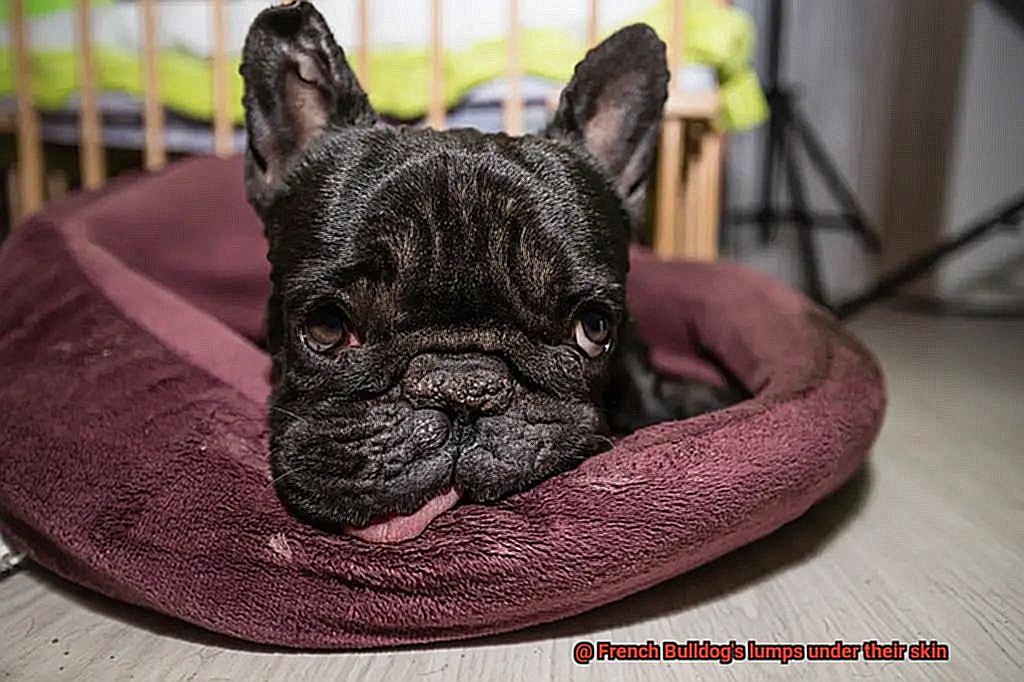
Hard lumps are often caused by tumors, while soft lumps can be attributed to cysts, infections, or other conditions. If the lump is hard and firm, this may be a sign of cancer. On the other hand, if the lump is soft and squishy, it could be caused by an infection or cyst.
No matter what kind of lump your dog has, it is important to keep an eye on any changes in its size or shape as this may indicate a more serious condition.
How to Check for Lumps Under Your Dog’s Skin
Gather Supplies
Before you begin, it’s important to have the right supplies on hand. You’ll need a pair of latex gloves, a flashlight, and a comb.
The gloves will help protect your hands from any bacteria that may be present, while the flashlight will help you see better in hard-to-reach areas. The comb will help you feel for any lumps or bumps that may not be visible to the naked eye.
Part the Fur
Once you have your supplies ready, it’s time to start looking for lumps. Start by gently parting your dog’s fur with your hands. Look closely at the skin and feel for any lumps or bumps that may be present.
If you find any, make sure to note their size and shape so that you can monitor them over time.
Check All Areas
Next, use your comb to part the fur in different areas of your dog’s body. Be sure to check around the neck, chest, belly, legs, and tail.
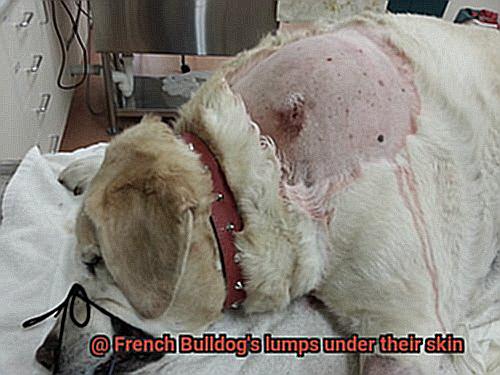
Pay special attention to areas where lumps are more likely to form, such as near the joints or areas where your dog has been injured in the past.
Monitor Lumps Over Time
If you find any lumps on your dog’s body, it’s important to monitor them over time. Make sure to check them regularly and take note of any changes in size or shape.
If you notice any changes, it’s best to take your dog to the vet for further examination.
Seek Professional Help
Finally, if you’re ever concerned about a lump on your dog’s body, don’t hesitate to seek professional help.
Your vet can provide a thorough examination and determine whether or not the lump is cause for concern. They may also recommend further tests or treatments if necessary.
Prevention Tips for Reducing the Risk of Lump Development in French Bulldogs
There are a few prevention tips you can follow to help reduce the chances of it happening.
Provide a high-quality diet
A nutritious and balanced diet is key for keeping your French Bulldog healthy and reducing their risk of developing lumps. Make sure they’re getting all the necessary vitamins and minerals they need to keep their immune system strong.
Ensure adequate exercise
Regular exercise is essential for maintaining your pup’s overall wellbeing, and can help reduce the risk of lump formation. Take them out for regular walks or play some fun games together – just make sure they get enough physical activity throughout the day!
Keep them clean
Grooming and bathing regularly will help minimize the chances of lumps developing on their skin. Make sure their coat is kept clean and free of dust, as this could be a contributing factor to lump formation.
Monitor their weight
Being overweight can raise the risk of lump formation in French Bulldogs, so it’s important to keep an eye on your pup’s weight and adjust their diet accordingly if they start to shed a few pounds.
Avoid exposure to toxins
Make sure your French Bulldog isn’t exposed to any chemicals or toxins that might lead to lumps under their skin – such as smoke, cleaning products, pesticides, etc.
Have regular check-ups
Taking your dog for regular check-ups with a vet can help identify any potential issues early on and prevent them from progressing into larger problems such as lumps under the skin. This way, if anything does arise, you can have it treated right away before it becomes a bigger issue down the line.
When to See a Vet About Your Dog’s Lump
When it comes to your French Bulldog’s health, any lump or bump should be taken seriously. From benign to cancerous, lumps can have a variety of causes and require the attention of a qualified vet.
If the lump is hard, red, or painful, it’s especially important to seek medical help right away as these could be signs of a more serious condition. Your vet will likely perform a biopsy to determine the source of the lump and may recommend further testing or treatment depending on the results.
It’s also important to keep an eye on any lumps for changes in size or texture and make sure your dog stays healthy with regular checkups at the vet’s office.
Also Read: Why Do English Bulldogs Have Skin Allergies?
Conclusion
It’s important to keep an eye out for any changes in your French Bulldog’s skin, as some lumps can be cancerous or painful.
Fortunately, most are benign and can be safely removed by surgery or other procedures. However, it’s still essential to have any suspicious lump examined by a veterinarian to determine its source and if treatment is necessary.
French Bulldogs can develop a variety of lumps, from fatty tumors to cysts and histiocytomas.
Knowing the common causes of these lumps, how to look for them, and when to seek help from a vet will help keep your pup healthy and happy for years to come.
You can also help minimize the likelihood of lump formation in French Bulldogs by regular checkups, proper diet and exercise, avoiding exposure to chemicals, and monitoring their weight.
By learning more about the French Bulldog’s lumps under their skin, you’ll be able to spot any potential problems early on and take the appropriate steps to ensure your dog gets the care they need.
